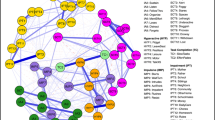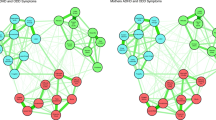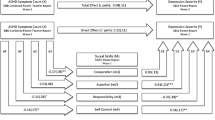Abstract
Multisource network and latent variable models were used to examine the construct validity of sluggish cognitive tempo (SCT) symptoms relative to attention-deficit/hyperactivity disorder-inattentive (ADHD-IN) and depressive symptoms. The five objectives were to determine the (1) distinctiveness of SCT, ADHD-IN, and depressive symptom communities, (2) similarity of the three symptom communities across mother, father, and teacher ratings, (3) individual symptoms with the strongest influence on other symptoms, (4) individual symptoms with the strongest relations to academic and social impairment, and (5) similarity between network and latent variable model results. Mothers, fathers, and teachers rated SCT, ADHD-IN, and depressive symptoms for 2,142 Spanish children (49.49% girls, ages 8–13 years, third to sixth grade). Walktrap community analysis resulted in SCT, ADHD-IN, and depressive symptom communities with three SCT symptom communities within the overall SCT symptom community (daydreams, mental confusion, and hypoactive communities). The symptom networks were also similar across mothers, fathers, and teachers, especially mothers and fathers. Finally, for all three sources, the same two SCT and two ADHD-IN symptoms showed unique relations with academic impairment and the same depressive symptom showed unique relations with social impairment. A latent variable model yielded equivalent results. Both models thus supported the validity of SCT symptoms relative to ADHD-IN and depressive symptoms. Complexities are noted in the selection of network and latent variable models to study child and adolescent psychopathology with recommendations for their selection.



Similar content being viewed by others
Notes
Bringmann and Eronen (2018) describe different versions of a latent variable model (i.e., there is no single latent variable model). The version described in the first paragraph is the one most often used for research on psychopathology. In addition, although the identification of internal and external correlates of the common variance in the syndrome constitutes a type of explanation, the identification of causal processes is much more complex.
The Spanish data has been used in a series of studies to investigate the reliability and construct validity of scores from the scales of the Child and Adolescent Behavior Inventory (Burns et al., 2020, 2021, 2021; Sáez et al., 2019; Servera et al., 2018). These earlier studies used the latent variable model. Aspects of the findings from these earlier studies provide the framework for the comparison of the network and latent variable models in the current study.
Given our focus on the SCT, ADHD-IN, and depression symptoms, the complexity of this NM, especially across the three sources, and the clear separation of the ADHD-hyperactive/impulsive, and inattentive symptoms in earlier NM studies (Goh et al., 2020; Martel et al. in press; Preszler & Burns, 2019; Preszler et al., 2020), this study did not include the hyperactive/impulsive symptoms.
The item lacks motivation to complete tasks, originally considered an SCT item, was expected to be part of the ADHD-IN symptom community due to its stronger relation with the ADHD-IN than SCT factor (Sáez et al., 2019).
The SCT factor was not separated into the three SCT subfactors for the exploratory structural regression analyses Additional research is required to determine the best SCT items to represent each subfactor and if the three SCT subfactors have unique and different associations with impairment relative to ADHD-IN and depression.
References
Asparouhov, T., & Muthén, B. (2009). Exploratory structural equation modeling. Structural Equation Modeling, 16, 397–438. https://doi.org/10.1080/10705510903008204
Barkley, R. A. (2013). Distinguishing sluggish cognitive tempo from ADHD in children and adolescents: Executive functioning, impairment, and comorbidity. Journal of Clinical Child and Adolescent Psychology, 42, 161–173. https://doi.org/10.1080/15374416.2012.734259
Bansal, P. S., Goh, P. K., Lee, C. A., & Martel, M. M. (2020). Conceptualizing callous-unemotional traits in preschool through confirmatory factor and network analysis. Journal of Abnormal Child Psychology. https://doi.org/10.1007/s10802-019-00611-9
Başay, O., Çiftçi, E., Becker, S. P., & Burns, G. L. (2021). Validity of sluggish cognitive tempo in Turkish children and adolescents. Child Psychiatry and Human Development, 52, 191–199. https://doi.org/10.1007/s10578-020-01110-5
Becker, S. P. (2021). Systematic review: Assessment of sluggish cognitive tempo over the past decade. Journal of the American Academy of Child and Adolescent Psychiatry, 60, 690–709. https://doi.org/10.1016/j.jaac.2020.10.016
Becker, S. P., Garner, A. A., Tamm, L., Antonini, T. N., & Epstein, J. N. (2019). Honing in on the social difficulties associated with sluggish cognitive tempo in children: Withdrawal, peer ignoring, and low engagement. Journal of Clinical Child and Adolescent Psychology, 48, 228–237. https://doi.org/10.1080/15374416.2017.1286595
Becker, S. P., Leopold, D. R., Burns, G. L., Jarrett, M. A., Langberg, J. M., Marshall, S., & A., ... Willcutt, E. G. (2016). The internal, external, and diagnostic validity of sluggish cognitive tempo: A meta-analysis and critical review. Journal of the American Academy of Child and Adolescent Psychiatry, 55, 163–178. https://doi.org/10.1016/j.jaac.2015.12.006
Becker, S. P., Mossing, K. W., Zoromski, A. K., Vaughn, A. J., Epstein, J. N., Tamm, L., & Burns, G. L. (2020). Assessing sluggish cognitive tempo and ADHD inattention in elementary students: Empirical differentiation, invariance across sex and grade, and measurement precision. Psychological Assessment, 32, 1047–1056. https://doi.org/10.1037/pas0000946
Bringmann, L. F. (2021). Person-specific networks in psychopathology: Past, present, and future. Current Opinions in Psychology, 41, 59–64. https://doi.org/10.1016/j.copsyc.2021.03.004
Bringmann, L. F., Elmer, T., Epskamp, S., Krause, R. W., Schoch, D., Wichers, M., Wigman, J., & Snippe, E. (2019). What do centrality measures measure in psychological networks? Journal of Abnormal Psychology, 128, 892–903. https://doi.org/10.1037/abn000044
Bringmann, L. F., & Eronen, M. I. (2018). Don’t blame the model: Reconsidering the network approach to psychopathology. Psychological Review, 125, 606–615. https://doi.org/10.1037/rev0000108
Burns, G. L., Geiser, C., Servera, M., Becker, S. P., & Beauchaine, T. P. (2020). Application of the bifactor S – 1 model to multisource ratings of ADHD/ODD symptoms: An appropriate bifactor model for symptom ratings. Journal of Abnormal Child Psychology, 48, 881–894. https://doi.org/10.1007/s10802-019-00608-4
Burns, G. L., & Becker, S. P. (2021). Sluggish cognitive tempo and ADHD symptoms in a nationally representative sample of U.S. children: Differentiation using categorical and dimensional approaches. Journal of Clinical Child and Adolescent Psychology, 50, 267–280. https://doi.org/10.1080/15374416.2019.1678165
Burns, G. L., Preszler, J., & Becker, S. P. (2021). Psychometric and normative information on the Child and Adolescent Behavior Inventory in a nationally representative sample of United States children. Journal of Clinical Child and Adolescent Psychology. Advance online publication. https://doi.org/10.1080/15374416.2020.1852943
Burns, G. L., Servera, M., & Becker, S. P. (2021). Psychometric properties and normative information on the Child and Adolescent Behavior Inventory with ratings for Spanish children from parents and teachers. Psicothema, 33, 139–145. https://doi.org/10.7334/psicothema2020.267
Christensen, A. P., & Golino, H. (2021). On the equivalency of factor and network loadings. Behavioral Research Methods. https://doi.org/10.3758/s13428-020-01500-6
Christensen, A. P., Golino, H., & Silvia, P. J. (2020). A psycometric network perspective on the validity and validation of personality trait questionnaires. European Journal of Personality. Advance online. https://doi.org/10.1002/per.2265
Csardi, G., & Nepusz, T. (2006). The igraph software package for complex network research. InterJournal, Complex Systems, 1695, 1–9.
Eadeh, H-M., Markon, K. E., Nigg, J. T., & Nikolas, M. A. (2021). Evaluating the viability of neurocognition as a transdiagnostic construct using both latent variable models and network analysis. Research on Child and Adolescent Psychopathology. https://doi.org/10.1007/s10802-021-00770-8
Epskamp, S., Borsboom, D., & Fried, E. I. (2018). Estimating psychological networks and their accuracy: A tutorial paper. Behavior Research Methods, 50, 195–212.
Epskamp, S., & Fried, E. I. (2018). A tutorial on regularized partial correlation networks. Psychological Methods, 23, 617–634. https://doi.org/10.1037/met0000167
Fried, E. I., van Borkulo, C. D., Cramer, A. O., Boschloo, L., Schoevers, R. A., & Borsboom, D. (2017). Mental disorders as networks of problems: A review of recent insights. Social Psychiatry and Psychiatric Epidemiology, 52, 1–10. https://doi.org/10.1007/s00127-016-1319-z
Garner, A. A., Mrug, S., Hodgens, B., & Patterson, C. (2013). Do symptoms of sluggish cognitive tempo in children with ADHD symptoms represent comorbid internalizing difficulties? Journal of Attention Disorders, 17, 510–518. https://doi.org/10.1177/1087054711431456
Goh, P. K., Martel, M. M., & Barkley, R. A. (2020). Clarifying ADHD and sluggish cognitive tempo item relations with impairment: A network analysis. Journal of Abnormal Child Psychology, 48, 1047–1061. https://doi.org/10.1007/s10802-020-00655-2
Goh, P. K., Smith, T. E., Lee, C. A., Bansal, P. S., Eng, A. G., & Martel, M. M. (2021). Etiological networks of attention-deficit/hyperactivity disorder during childhood and adolescence. Journal of Clinical Child and Adolescent Psychology. https://doi.org/10.1080/15374416.2021.1946820
Golino, H. F., & Epskamp, S. (2017). Exploratory graph analysis: A new approach for estimating the number of dimensions in psychological research. PLoS One, 12, e0174035. https://doi.org/10.1371/journal.pone.0174035
Haslbeck, J., & Waldorp, L. J. (2015). mgm: Estimating time-varying mixed graphical models in high-dimensional data. ar**v preprint. https://arxiv.org/abs/1510.06871
Jung, S. H., Lee, S. Y., Burns, G. L., & Becker, S. P. (2020). Internal and external validity of self-report and parent-report measures of sluggish cognitive tempo in South Korean adolescents. Journal of Psychopathology and Behavioral Assessment. Advance online publication. https://doi.org/10.1007/s10862-020-09821-8
Martel, M. M., Goh, P. K., Lee, C. A., Karalunas, S. L., & Nigg, J. T. (in press). Longitudinal attention-deficit/hyperactivity disorder symptom networks in childhood and adolescence: Key symptoms, stability, and predictive validity. Journal of Abnormal Psychology. https://doi.org/10.1037/abn0000661
McNally, R. J. (2016). Can network analysis transform psychopathology? Behaviour Research and Therapy, 86, 95–104. https://doi.org/10.1016/j.brat.2016.06.006
Mullarkey, M. C., Marchetti, I., & Beevers, C. G. (2019). Using network analysis to identify central symptoms of adolescent depression. Journal of Clinical Child and Adolescent Psychology, 48, 656–668. https://doi.org/10.1080/15374416.2018.1437735
Preszler, J., & Burns, G. L. (2019). Network analysis of ADHD and ODD symptoms: Novel insights or redundant findings with the latent variable model? Journal of Abnormal Child Psychology, 47, 1599–1610. https://doi.org/10.1007/s10802-019-00549-y
Preszler, J., Burns, G. L., Becker, S. P., & Servera, M. (2020). Multisource longitudinal network and latent variable model analyses of ADHD symptoms in children. Journal of Clinical Child and Adolescent Psychology. https://doi.org/10.1080/15374416.2020.1756297
Sáez, B., Servera, M., Becker, S. P., & Burns, G. L. (2019). Optimal items for assessing sluggish cognitive tempo in children across mother, father, and teacher ratings. Journal of Clinical Child and Adolescent Psychology, 48, 1–15. https://doi.org/10.1080/15374416.2017.1416619
Servera, M., Saez, B., Burns, G. L., & Becker, S. P. (2018). Clinical differentiation of sluggish cognitive tempo and attention-deficit/hyperactivity disorder in children. Journal of Abnormal Psychology, 127, 818–829. https://doi.org/10.1037/abn0000375
van Bork, R., Rhemtulla,M., Waldorp, L. J., Kruis, J., Rezvanifar, S., & Borsboom, D. (2019). Latent variable models and networks: Statistical equivalence and testability. Multivariate Behavioral Research, 1–24. https://doi.org/10.1080/00273171.2019.1672515
Acknowledgements
The authors would like to acknowledge the discussions with Alexander P. Christensen on network and latent variable models. These discussions were helpful in the revisions of this paper.
Funding
This research was supported by two grants from the Ministry of Economy and Competitiveness of Spanish Government under award numbers PSI2014-52605-R and PSI2017-82550-R (AEI/FEDER, UE), and a predoctoral fellowship co-financed by MINECO (Spanish Government) and the European Social Fund (BES-2015–075142). The content is solely the responsibility of the authors and does not necessarily represent the official views of the Spanish Government. We thank Cristina Trias for assistance with the study.
Ministerio de Economía y Competitividad,PSI2014-52605-R PSI2017-82550-R, Mateu Servera, National Institutes of Health, K23MH108603, Stephen Becker.
Author information
Authors and Affiliations
Corresponding author
Ethics declarations
Ethical Approval
The research protocol was approved by the Research Ethics Committee (Institutional Review Board [IRB]) of the University of the Balearic Islands.
Informed Consent
Mothers, fathers, and teachers provided written informed consent.
Conflict of Interest
The authors of the current study declare that they have no conflicts of interest.
Additional information
Publisher's Note
Springer Nature remains neutral with regard to jurisdictional claims in published maps and institutional affiliations.
Supplementary Information
Below is the link to the electronic supplementary material.
Rights and permissions
About this article
Cite this article
Burns, G.L., Preszler, J., Ahnach, A. et al. Multisource Network and Latent Variable Models of Sluggish Cognitive Tempo, ADHD-Inattentive, and Depressive Symptoms with Spanish Children: Equivalent Findings and Recommendations. Res Child Adolesc Psychopathol 50, 881–894 (2022). https://doi.org/10.1007/s10802-021-00890-1
Accepted:
Published:
Issue Date:
DOI: https://doi.org/10.1007/s10802-021-00890-1




